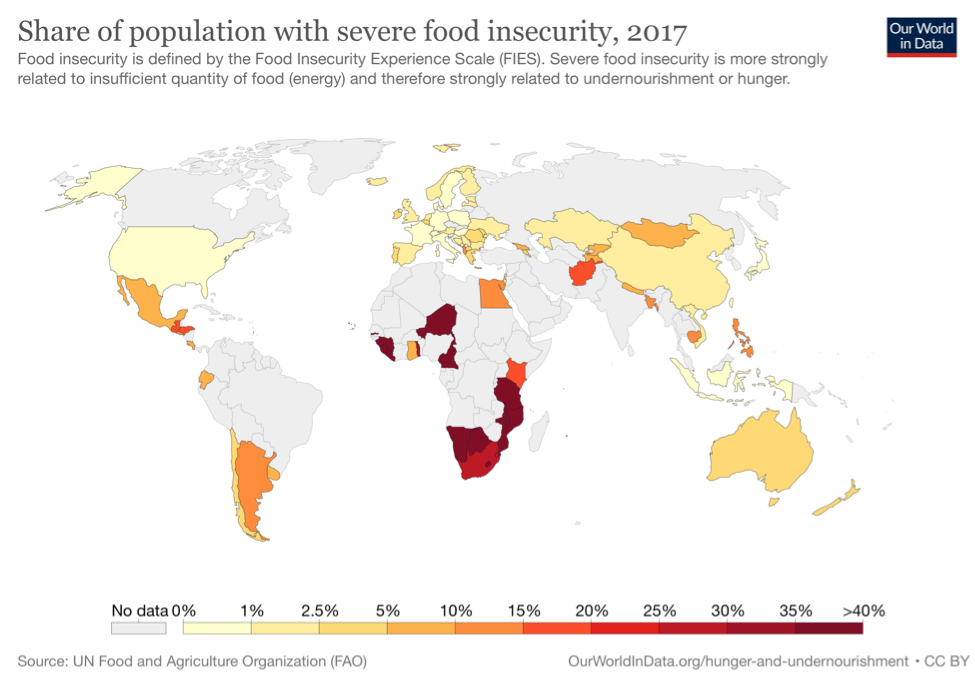The information here is provided by courtesy of the Network's short online course - "An Introduction to Global Health".
Good Nutrition
Good nutrition is crucial for health and development. It is related to improved infant, child and maternal health, stronger immune systems, safer pregnancy and childbirth and low risk of non-communicable diseases such as diabetes and cardiovascular disease.
Healthy children learn better and people with adequate nutrition are more productive.
Malnutrition
Malnutrition refers to deficiencies, excesses or imbalances in a person’s intake of energy and/or nutrients. The term includes people who are
- overweight and obese (this is described in the section on Non-Communicable Diseases).
- under-nourished (see below)
Under-Nutrition
Around 45% of deaths in children under 5 years are linked to under-nutrition. Most of these are in low- and middle-income countries. Under-nutrition can be divided into
- Wasting
- Stunting
- Underweight
- Micro-nutrient malnutrition
a) Wasting : Low weight-for-height
This usually indicates recent and severe weight loss. Commonly this is because a child has not had enough food to eat and/or they have had an infectious disease such as diarrhoea, which has caused them to lose weight. A young child who is moderately or severely wasted has an increased risk of death, but treatment is possible.
Of the children in the world who are under 5 years of age
- 47 million are wasted
- 3 million are severely wasted
The level of wasting varies very much between countries, it being particularly marked in countries in Africa and South Asia (Map 1)
Map 1

b) Stunting : Low height for age
This is the result of chronic or recurrent undernutrition, usually associated with poor socioeconomic conditions, poor maternal health and nutrition, frequent illness, and/or inappropriate infant and young child feeding and care in early life.
- Stunting holds children back from reaching their physical and cognitive potential.
- 144 million children under years in the world are stunted
The level of stunting varies very much between countries, it being particularly marked in countries in Africa and South Asia (Map 2)
Map 2

c) Underweight : low weight-for-age
A child that is underweight may be stunted, wasted or both.
As with the other forms of malnutrition is unevenly distributed across the world (Map 3)
Map 3

d) Micronutrient-related malnutrition : Deficiencies of important vitamins and minerals
Micronutrients enable the body to produce enzymes, hormones and other substances essential for proper growth and development. In global public health terms iodine, vitamin A and iron are the most important, especially for children and pregnant women in low-income countries.
By way of illustration, the distribution of anaemia in children across the world in map 4.
Map 4

For detailed information about other forms of micronutrient-related malnutrition follow the link below to visit
Food Insecurity
Food insecurity as defined by the UN Food and Agricultural Organisation is the situation when people lack secure access to sufficient amounts of safe and nutritious food for normal growth and development and an active and healthy life.
It can be caused by a number of factors, including the unavailability of food, unaffordable food, and unequal distribution of food between household members. It is one of the major causes of poor nutrition and mainly occurs in low-income countries. Map 5 shows the position in 2017, but the picture changes year by year.
Map 5

What is WHO doing?
Progress on reducing malnutrition is felt to be slow. WHO works with member states to achieve the following targets by 2025
- 40% reduction of the global number of children under five who are stunted (baseline 2010)
- 50% reduction of anaemia in women of reproductive age (baseline 1993 - 1995)
- 30% reduction of low birth weight (baseline 2006 - 2010)
- no increase in childhood overweight (baseline 2010)
- increase the rate of exclusive breastfeeding in the first six months up to at least 50% (baseline 2006 - 2010)
- reduce and maintain childhood wasting to less than 5% (baseline 2010)
These are outlined in the "Comprehensive implementation plan on maternal, infant and young child nutrition" (see link below).
Further Reading
Sustainable Development Goal 2 "No Hunger"
https://sdgs.un.org/goals/goal2
Our World in Data : More on under-nutrition and food insecurity
https://ourworldindata.org/hunger-and-undernourishment
WHO : Malnutrition
https://www.who.int/news-room/fact-sheets/detail/malnutrition




